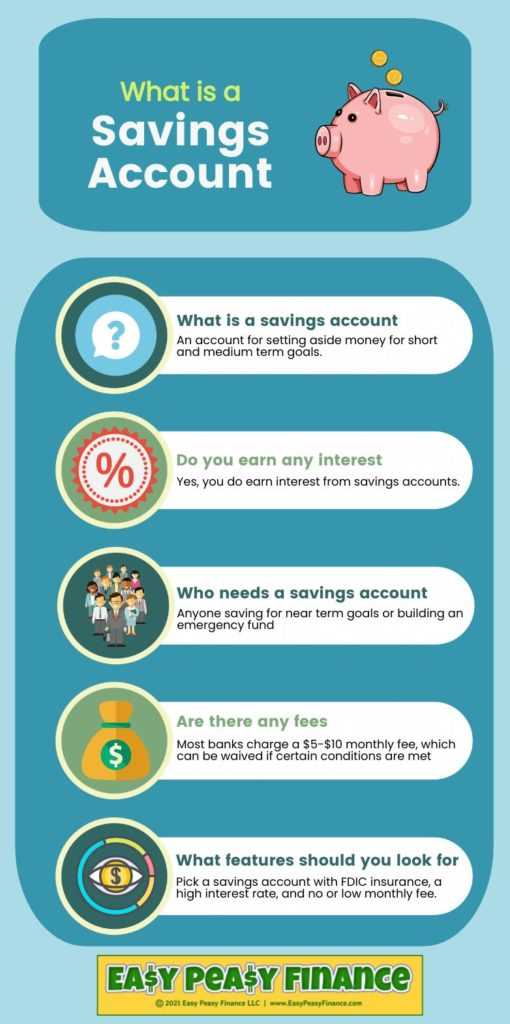What Is a Savings Account?
A savings account is a type of bank account that allows individuals to deposit and save money while earning interest on their savings. It is a secure place to store funds and is typically offered by banks, credit unions, and other financial institutions.
How Does a Savings Account Work?
When you open a savings account, you are essentially lending money to the bank. The bank then uses these funds to provide loans and other financial services to individuals and businesses. In return for depositing your money, the bank pays you interest on the balance of your account.
Most savings accounts have certain requirements and restrictions, such as minimum balance requirements and limits on the number of withdrawals you can make per month. These restrictions are in place to encourage individuals to save and to ensure the stability of the banking system.
Benefits of Having a Savings Account
There are several benefits to having a savings account:
- Interest Earnings: By keeping your money in a savings account, you can earn interest on your balance, allowing your savings to grow over time.
- Security: Savings accounts are insured by the FDIC, providing protection for your funds in case the bank fails.
- Liquidity: Unlike some other investments, savings accounts offer easy access to your money, allowing you to withdraw funds whenever you need them.
- Financial Goals: A savings account can help you save for specific financial goals, such as a down payment on a house, a vacation, or an emergency fund.
Overall, a savings account is a reliable and convenient way to save money, earn interest, and achieve your financial goals. It is an essential tool for financial planning and building wealth over time.
Tips for Managing Your Savings Account
To make the most of your savings account, consider the following tips:
- Set a savings goal and regularly contribute to your account to reach that goal.
- Take advantage of any employer matching contributions to your savings account, if available.
- Shop around for the best interest rates and account terms before opening a savings account.
- Monitor your account balance and fees to ensure you are maximizing your savings and avoiding unnecessary charges.
- Consider automating your savings by setting up automatic transfers from your checking account to your savings account.
By following these tips, you can effectively manage your savings account and make the most of your savings efforts.
How Does a Savings Account Work?
A savings account is a type of bank account that allows individuals to deposit and save their money while earning interest on their balance. It is a secure and convenient way to store and grow your savings.
Here is how a savings account works:
- Opening an Account: To open a savings account, you need to visit a bank or financial institution and provide the necessary identification and documents. Some banks also offer online account opening options.
- Deposit: Once your account is opened, you can deposit money into it. You can deposit funds through cash, checks, or electronic transfers. The bank will provide you with a deposit slip or account number to facilitate the deposit process.
- Interest: One of the main benefits of a savings account is that it earns interest on the deposited funds. The interest rate is determined by the bank and may vary depending on the type of savings account and prevailing market rates. The interest is usually calculated on a daily or monthly basis and added to your account balance.
- Withdrawal: You can withdraw money from your savings account whenever you need it. Most banks offer various withdrawal options, including ATM withdrawals, online transfers, and in-person withdrawals at the bank branch. However, there may be limits on the number of withdrawals you can make per month without incurring fees.
- Minimum Balance: Some savings accounts require a minimum balance to be maintained. If your account falls below the minimum balance, you may be charged a fee or your account may be converted to a different type of account with different terms and conditions.
- Account Statements: Banks provide regular account statements that show your deposits, withdrawals, and interest earned. It is important to review these statements to ensure accuracy and monitor your savings progress.
Overall, a savings account provides a safe and accessible way to save money while earning interest. It is important to compare different banks and their offerings to find the best savings account that suits your financial goals and needs.
Benefits of Having a Savings Account
A savings account is a financial tool that offers a range of benefits to individuals looking to save money and achieve their financial goals. Here are some key benefits of having a savings account:
1. Interest Earnings
One of the primary benefits of a savings account is the opportunity to earn interest on your deposited funds. Unlike a checking account, which typically offers little to no interest, a savings account allows your money to grow over time. The interest rate may vary depending on the bank and the type of savings account you have, but even a small interest rate can add up over time.
2. Safety and Security

Another advantage of a savings account is the safety and security it provides for your money. Unlike keeping cash at home or carrying it around, a savings account keeps your funds protected in a bank. Banks are regulated and insured, which means that even if the bank fails, your deposits are typically insured up to a certain amount by the government. This provides peace of mind and ensures that your hard-earned money is safe.
3. Easy Access to Funds
While a savings account is designed to help you save money, it also provides easy access to your funds when you need them. Most savings accounts allow you to withdraw money at any time through various channels such as ATM withdrawals, online transfers, or in-person visits to the bank. This flexibility ensures that you can access your savings whenever an unexpected expense arises or when you need to make a planned purchase.
4. Goal Setting and Financial Planning
A savings account can serve as a valuable tool for goal setting and financial planning. By having a designated account for your savings, you can track your progress towards specific financial goals, such as buying a house, starting a business, or saving for retirement. Setting aside a portion of your income regularly into a savings account can help you stay disciplined and focused on achieving your long-term financial objectives.
5. Overdraft Protection
Some savings accounts offer overdraft protection, which can be a useful feature to have. If you have a linked checking account and you accidentally overdraw from it, the bank can automatically transfer funds from your savings account to cover the overdraft. This can help you avoid costly overdraft fees and ensure that your transactions are processed smoothly.
Tips for Managing Your Savings Account

Managing your savings account effectively is essential for reaching your financial goals. Here are some tips to help you make the most of your savings:
1. Set Clear Goals
2. Create a Budget
A budget is a crucial tool for managing your savings account. Track your income and expenses to understand where your money is going. Identify areas where you can cut back on spending and allocate those savings to your savings account. Stick to your budget to ensure you’re saving consistently.
3. Automate Your Savings
Make saving a habit by setting up automatic transfers from your checking account to your savings account. This way, a portion of your income will be automatically saved without you having to think about it. It’s an effective way to ensure regular contributions to your savings.
4. Shop Around for the Best Interest Rates
Interest rates can vary significantly between different savings accounts. Take the time to research and compare interest rates offered by different banks or financial institutions. Choosing an account with a higher interest rate will help your savings grow faster over time.
5. Avoid Unnecessary Fees
Read the terms and conditions of your savings account carefully to understand any fees associated with it. Avoid unnecessary fees by maintaining the minimum balance required, limiting the number of withdrawals, and being aware of any monthly maintenance fees. This way, you can maximize the returns on your savings.
6. Review and Adjust Regularly
Regularly review your savings account and make adjustments as needed. Assess whether you’re on track to meet your savings goals and make any necessary changes to your budget or savings strategy. Stay proactive in managing your savings to ensure you’re making progress towards your financial objectives.
| Tips for Managing Your Savings Account |
|---|
| 1. Set Clear Goals |
| 2. Create a Budget |
| 3. Automate Your Savings |
| 4. Shop Around for the Best Interest Rates |
| 5. Avoid Unnecessary Fees |
| 6. Review and Adjust Regularly |
By following these tips, you can effectively manage your savings account and make progress towards your financial goals. Remember to stay disciplined and consistent in your savings habits to achieve long-term financial success.

Emily Bibb simplifies finance through bestselling books and articles, bridging complex concepts for everyday understanding. Engaging audiences via social media, she shares insights for financial success. Active in seminars and philanthropy, Bibb aims to create a more financially informed society, driven by her passion for empowering others.
